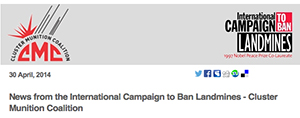24 May 2013
ICBL Comments on Chad’s Article 5 Extension Request
Download the Critique Key Issues
- There remains a lack of clarity on the estimated size of contamination.
- Annual plans in the 2013-2017 Mine Action Strategy do not seem to match the annual plans in the extension request.
- Chad acknowledges management issues have hampered past progress, and puts forward a plan for building national capacity.
Observations and RecommendationsPast Progress Despite having received two previous extensions to clarify the extent of contamination, Chad still does not present a clear picture of remaining contamination. According to page 7 of the extension request, the size of contamination in 2013 is about 61.2 km2. This includes contamination by landmines and ERW. According to page 22 of the 2013-2017 Mine Action Strategy it has annexed to the request, the size of contamination is 127.56 km2 (including both landmines and ERW). According to Annex X, the size of contamination as of 26 March 2013 is about 121 km2. For the department of Tibesti alone, and knowing that survey in that department is not complete yet, the extension request says there are 19.4 km2 of contamination (including both landmines and ERW), while the 2013-2017 Strategy says that 66.7 km2 must be addressed.
Recommendation: Chad should clarify its estimate of remaining contamination and, to the extent feasible, disaggregate data by type of contamination since Article 5 applies to antipersonnel mines only.The request acknowledges that poor management and financial transparency issues have impeded clearance activities. Such an acknowledgement is positive in the ICBL’s view, and Chad is reportedly already taking remedy measures and has a detailed plan to build national capacity.
Recommendation: The ICBL encourages Chad to report to States Parties on management changes and capacity building measures, and to increase dialogue with donors and other stakeholders as planned in the 2013-2017 Mine Action Strategy.Prioritization of areas to be cleared seems adequate in Chad, involves a range of stakeholders and is based on the humanitarian impact of contamination.
Recommendation: The ICBL encourages Chad to continue its consultative approach to task prioritization.Chad notes that land cleared in the past years has not been handed over to local populations, but that handover will be ensured from now on.
Recommendation: Throughout the extension period, Chad should report to States Parties on land released and handed over.
Plans for Extension Period Chad is requesting until 2019 to complete its Article 5 obligations, though it does not provide many details on annual operational plans in the narrative part of the extension request. Its 2013-2017 Mine Action Strategy does include some level of detail on annual land release, but adds confusion to the request by forecasting completion of clearance in 2017.
Clearance activities projected to end in 2019 in the extension request, such as for the departments of Ennedi and Borkou, actually are planned to end in 2017 in the 2013-2017 Mine Action Strategy. Therefore, though we can assume Chad intends to carry out clearance through the end of its extension period, there is no corresponding plan for the final two years. This plus the lack of clarity on total remaining contamination cited above makes it difficult to assess the amount of time requested. Chad notes that a mid-term review of clearance activities is planned for 2015 further to the review of the National Development Plan, at which point it might be possible to carry out further planning.
Recommendation: Chad should clarify against which timeframe it intends to work, and should provide details on operations for 2018 and 2019. Alternatively, if it is not yet possible to plan for 2018-2019 due to security challenges in Tibesti, Chad should commit to submitting a detailed plan by 2017. Chad should commit to sharing the outcome of the 2015 review with States Parties and should ensure that any modification to the clearance plan does not negatively impact the end date.
Financing It is positive that Chad has included mine action in its national development plan, which signals it as a priority to international donors. However the request does not outline a mobilization plan for international resources. It is also very positive that Chad intends to fund a significant part of its program: the budget of the 2013-2017 Mine Action Strategy refers to an annual contribution of 4.6 million USD from Chad.
Recommendation: Further information on Chad’s international resource mobilization plan would also be helpful. Budget projections in the extension request (16 million USD) only refer to clearance funding, while budget projections in the 2013-2017 Mine Action Strategy (40.3 million USD) are more comprehensive and include items such as capacity building and quality management.
Recommendation: Chad should consider presenting a full budget for the requested period, which will give potential donors a better portrait of the situation.


